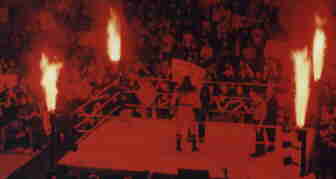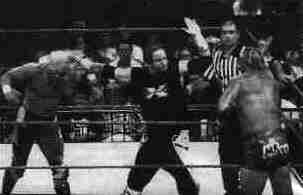

Off the ropes
From its humble beginnings, professional wrestling explodes into a multi-million dollar industry
Published 10/8/98
It's not a typical night at the Pittsburgh Civic Arena.
As more than 16,000 people look on, two individuals repeatedly punch each other while standing atop a 16-foot steel cage that looks like it's ready to collapse.
Vowing to settle this feud once and for all, one of the combatants, whose arms are covered with tattoos, throws his opponent over the cage's side onto a table down below, which shatters into dozens of fragmented splinters.
Instead of shrieking in horror, the bloodthirsty crowd erupts into a frenzied yell as paramedics come out. Because the cage is in the way of the medics, it has to be raised several feet up in the air in order for them to reach the victim, who is lying motionless on the floor.
While the injured man is carried off on a stretcher, the cage begins to lower, and as the man who caused this chaos begins to climb down the cage, one link at a time, the crowd begins to stir.
As the man climbing down looks on, the person who he threw off the cage is suddenly rushing back towards him amid a legion of paramedics who are trying to sway his decision. Both men proceed to climb back up the cage to wage war once again. All the while the thousands of people on hand hoot and holler in approval.
What would cause ordinary people to act in this unruly manner? Are they being brainwashed to accept gratuitous violence? Was this a barroom fight turned nasty? No. Its a professional wrestling match.
The the chagrin of pacifists across America, wrestling is back and it's bigger than ever. Revenues are soaring and ratings are rising faster than people can turn on their televisions. And although critics say that wrestling fads often come and go, this current craze just might have enough staying power to last for a while.
History
Wrestling can be considered one of mankind's oldest forms of competition. There's evidence that ancient Egyptians, Romans, Greeks and Native Americans often wrestled to settle differences between one another. However, instead of tag-team fights or steel-cage matches, most bouts were methodical and time-consuming, lasting for hours at a time.
During the Civil War, soldiers often wrestled in between battles for amusement, and after the war ended some ex-soldiers joined traveling carnivals and became sideshow attractions.
As each carnival arrived in different towns, these wrestlers would grant a cash award to those locals who lasted a certain amount of time with them in a ring. More often than not, the wrestlers came out on top.
When America urbanized at the turn of the century, some carnival owners moved into cities and established their own wrestling circuits.
Over the years, professional wrestling developed in order to attract an audience. Instead of lengthy, scientific matches that often bored its spectators to sleep, many promoters made matches shorter and offered several different contests. While adapting to an ever-changing market, wrestling flourished in the early 1900s.
Much like everything else in America during the 1930s, professional wrestling experienced a decline due to the Great Depression. Even as America entered World War II and got its economy back on track, wrestling still had difficulty drawing people. Once problem was because the radio, a new household device at the time, didn't offer the listener much when it came to wrestling matches. Hearing someone get body slammed and actually seeing it happen were two different events, and the customers and promoters knew it.
Wrestling came back into prominence in the 1950s with the invention of television. Unlike radio broadcasts, televised matches provided the viewer with an image that they could relate to. This new dimension also helped the wrestlers because they could now promote themselves to a larger audience, not just to those watching the event ringside. Wrestlers not only went after one another in the ring but also showed a more personal side of themselves by staging pre- and post-match interviews.
In addition to interviews, wrestlers capitalized on television by performing gimmicks, such as entering the ring in elegant costumes or behaving in a peculiar way. One wrestler was filmed having his head shaved after he lost a match to a hated rival, and, after losing the rematch, his wife's hair was buzzed as well.
Because
only several houses in a neighborhood
would have had a television set back in the '50s, friends and
neighbors would gather together and tune in to cheer on their
favorite wrestlers (known as "baby faces") or boo the
deceitful, shady wrestlers that could only win a match by
cheating (known as "heels").
neighborhood
would have had a television set back in the '50s, friends and
neighbors would gather together and tune in to cheer on their
favorite wrestlers (known as "baby faces") or boo the
deceitful, shady wrestlers that could only win a match by
cheating (known as "heels").
When the 1960s appeared, wrestling vanished from network television. During the boob tube's early years, wrestling was considered cheap, easy programming that attracted viewers. By now though, variety shows and westerns dominated the scene. Many wrestling promoters went back to their early days when each company sought out a specific territory and worked within its boundaries.
During this time, wrestling made another noteworthy development. Because normal wrestling techniques weren't satisfying spectators, more props like chairs were being used in order to give viewers a quick fix of gratuitous violence.
A second coming
Professional wrestling wasn't a multi-million dollar industry until a second-generation promoter named Vince McMahon Jr. bought his father's wrestling company and created the World Wrestling Federation. Instead of staying in his domain, located in the northeastern part of the United States, McMahon expanded his company nationwide.
Other wrestling promoters began to complain when McMahon began videotaping matches and sending them out to television stations across the country. Because McMahon was getting aired across the country, he was receiving more money from advertising revenue. With more money than his competitors, McMahon began to buy off all their talented stars, and soon thereafter, many local wrestling circuits went out of business.
One wrestler that McMahon was able to lure was a young blond named Terry Bollea, and McMahon changed his name to Hulk Hogan. With an appealing all-American image, Hogan became a household name to millions of Americans throughout the 1980s.
McMahon began to charge for specific aired wrestling events, or pay-per-views, which are still used today by wrestling companies. And although the cost of most pay-per-views today are in the $35 range, it is common for a group of people to chip in $5 or $6 apiece to watch an event, making these three-hour broadcasts affordable to most people.
The actual wrestling events were only the tip of the iceberg for McMahon's financial success. By marketing wrestling as a form of family entertainment, sales from other avenues began rolling in. Everything from action figures to ice cream bars were game as long as a wrestler's face donned the package's cover. This marketing strategy was paying large dividends to McMahon, thus earning the title given to him by Forbes magazine: "centimillionaire."
By the end of the 1980s, the WWF dominated the wrestling scene; however, due to a lack of competition, the company began to wane, and by the early 1990s, wrestling was in a downturn. Many wrestling fans found other things to occupy their time with, and the industry was faced with some difficult decisions.
During
the late '80s, billionaire Ted Turner bought a floundering
wrestling company and renamed it World Championship Wrestling.
With his deep pockets, Turner began drawing WWF stars away,
including Hogan, much like McMahon did back in the early '80s.
During the mid-'90s, WCW eventually overtook the WWF as the dominant wrestling organization. There was even talk of the WWF going bankrupt. However, with this new challenge by Turner and WCW, the WWF regrouped and began to create a new, racier image. One way this was achieved was to feature characters who acted and spoke a bit more saucy than their WCW counterparts.
In several ways, this war between the WWF and WCW executives is more entertaining than the matches they promote.
Both organizations have their prime-time broadcasts on at the same time Monday nights, trying to get higher ratings than their counterparts. Announcers frequently poke fun at the other wrestling company. WCW announcers make snide remarks about the WWF's sometimes prerecorded "live" broadcasts, and WWF announcers jab the WCW's occasional lack of physical contact between wrestlers.
In addition, both companies have filed lawsuits against the other. After a failed antitrust suit, the WWF is now suing WCW over trademark infringement and slander while WCW is counter-suing with similar allegations.
In a way, this choreographed showcase of athleticism mixed with some locker room mentality can be related to people of almost all ages and backgrounds. For example, who wouldn't want to give their boss a chokeslam or give their company higher-ups a middle-finger salute?
Today's wrestling entertainment can be considered a form of escapism because most of us who would try similar acts in the real world would be fired from our jobs or thrown in jail.
And even though most people tune into wrestling to escape everyday hassles and challenges, there is a real element to all the orchestrated chaos.
After his plummet off the steel cage, Mankind, the name of the wrestler who returned to the ring for more punishment, eventually lost his match. However while being helped off backstage, the arena faithful gave him a standing ovation.
A realistic ending to a world of fantasy.
Click here to return to feature index.